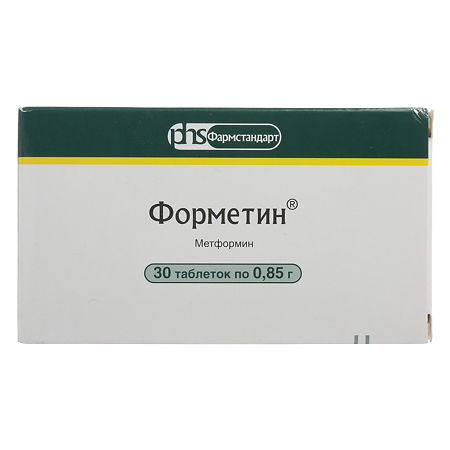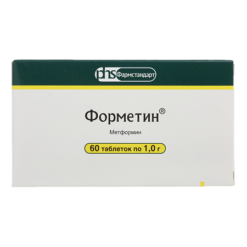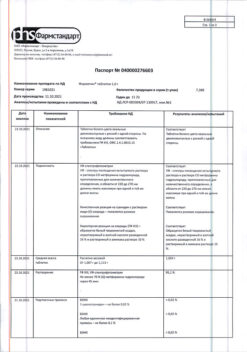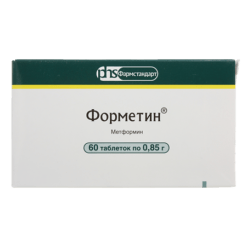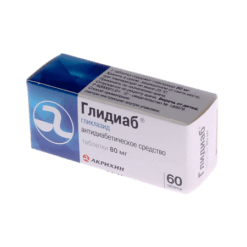No products in the cart.
Formetin, tablets 850 mg 30 pcs
€1.00
Out of stock
(E-mail when Stock is available)
Description
The oral hypoglycemic drug of the biguanide group.
Inhibits gluconeogenesis in the liver, reduces glucose absorption from the intestine, increases peripheral glucose utilization, and increases tissue sensitivity to insulin.
It has no effect on insulin secretion by pancreatic β-cells, does not cause hypoglycemic reactions. It reduces the level of triglycerides and LDL.
Stabilizes or reduces body weight. Has a fibrinolytic effect by inhibiting tissue-type plasminogen activator inhibitor.
Pharmacokinetics
Intake After oral administration metformin is absorbed from the GI tract. Bioavailability after a standard dose is 50-60%. Cmax after oral administration is reached after 2.5 hours.
Distribution Practically does not bind with plasma proteins. It accumulates in salivary glands, muscles, liver and kidneys. Excretion It is excreted unchanged in the urine. T1/2 is 1.5-4.5 hours.
Pharmacokinetics in special clinical cases
In impaired renal function, cumulation of the drug is possible.
Indications
Indications
Type 2 diabetes mellitus when diet therapy is ineffective (especially in obese patients).
Active ingredient
Active ingredient
Composition
Composition
Active substance:
metformin hydrochloride 850 mg;
Associates:
povidone medium molecular weight (polyvinylpyrolidone),
croscarmellose sodium,
magnesium stearate
How to take, the dosage
How to take, the dosage
Take 1 in the morning and evening. Maximum daily dose is 3 g.
In case of concomitant use of insulin at a dose of less than 40 units/day the dosing regimen of metformin is the same, and the insulin dose can be gradually reduced (by 4-8 units/day every other day).
If the insulin dose is greater than 40 units/day, metformin and insulin dose reduction require great caution and should be done in a hospital setting.
Interaction
Interaction
Incompatible with ethanol (lactate acidosis).
Prescribe with caution in combination with indirect anticoagulants and cimetidine. Sulfonylurea derivatives, insulin, acarbose, MAO inhibitors, oxytetracycline, ACE inhibitors, clofibrate, cyclophosphamide and salicylates increase the effect.
Concomitant use with GCS, oral hormonal contraceptives, epinephrine, glucagon, thyroid hormones, phenothiazine derivatives, thiazide diuretics, nicotinic acid derivatives may reduce the hypoglycemic effects of metformin.
Nifedipine increases absorption, Cmax, slows excretion. Cationic drugs (amiloride, digoxin, morphine, procainamide, quinidine, quinine, ranitidine, triamterene and vancomycin) that are secreted in the tubules compete for tubule transport systems and may increase Cmax by 60% with long-term therapy.
Special Instructions
Special Instructions
Key renal function should be monitored during treatment; plasma lactate determination should be performed at least twice a year, and also if myalgia occurs. If lactate acidosis develops, treatment should be discontinued. It is not recommended to prescribe if there is a danger of dehydration.
Major surgical interventions and trauma, extensive burns, infectious diseases with febrile syndrome may require withdrawal of oral glypoglycemic drugs and insulin administration.
When combined treatment with sulfonylurea derivatives, close monitoring of blood glucose concentrations is necessary. Combined use with insulin is recommended in a hospital.
Contraindications
Contraindications
– diabetic ketoacidosis, diabetic precoma, coma;
– expressed renal dysfunction;
– conditions that may contribute to lactacidosis, including. cardiac and respiratory insufficiency, acute phase of myocardial infarction, acute impairment of cerebral circulation, dehydration, chronic alcoholism; –
– acute alcohol poisoning;
– severe infectious diseases;
– lactacidosis (incl.Ñ. history);
– serious surgical operations and trauma (insulin therapy is indicated in these cases);
– Usage within 2 days before and 2 days after radioisotopic or X-ray studies with the administration of iodine-containing contrasting agent;
– keeping a hypocaloric diet (less than 1000 calories per day);
– Hypersensitivity to the components of the drug.
The drug is not recommended for patients older than 60 years of age who perform heavy physical work, due to the increased risk of lactacidosis.
Side effects
Side effects
Gastrointestinal system disorders: at the beginning of treatment – anorexia, diarrhea, nausea, vomiting, flatulence, abdominal pain (reduced with meals); metallic taste in the mouth (3%).
Cardiovascular system and blood (hematopoiesis, hemostasis): in single cases – megaloblastic anemia (due to impaired absorption of vitamin B12 and folic acid).
Metabolism disorders: hypoglycemia; in rare cases – lactate acidosis (weakness, somnolence, hypotension, resistant bradyarrhythmia, respiratory disorders, abdominal pain, myalgia, hypothermia).
Skin disorders: rash, dermatitis.
Overdose
Overdose
Symptoms: possible development of lactacidosis with fatal outcome. The cause of lactacidosis may also be cumulation of the drug due to renal dysfunction.
The early symptoms of lactacidosis are general weakness, nausea, vomiting, diarrhea, decreased body temperature, abdominal pain, muscle pain, decreased blood pressure, reflex bradyarrhythmia, later, rapid breathing, dizziness, impaired consciousness and development of coma may occur.
Treatment: if signs of lactacidosis occur, metformin treatment should be stopped immediately, the patient should be immediately hospitalized and, after determining the lactate concentration, the diagnosis should be confirmed. Hemodialysis is most effective in eliminating lactate and metformin from the body. If necessary, symptomatic therapy is carried out.
Pregnancy use
Pregnancy use
Formethine is contraindicated in pregnancy and during lactation (breastfeeding).
Similarities
Similarities
Additional information
| Shelf life | 2 years |
|---|---|
| Conditions of storage | Store in a place protected from light, at a temperature not exceeding 25°C. |
| Manufacturer | Pharmstandard-Leksredstva, Russia |
| Medication form | pills |
| Brand | Pharmstandard-Leksredstva |
Other forms…
Related products
Buy Formetin, tablets 850 mg 30 pcs with delivery to USA, UK, Europe and over 120 other countries.

